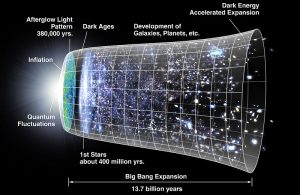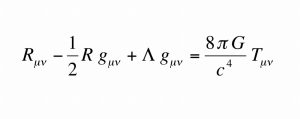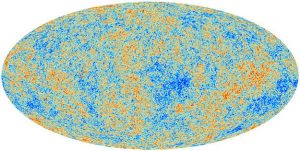We’ve all heard the old saying ‘Two steps forward, one step back’. Well, when it comes to Cosmology, the study of the Universe as a whole, it seems like we take a step forward, another sideways, close your eyes and spin, take two steps etc, etc, you get the idea. The Universe is so large, the measurements so difficult to make, the theories so complex that progress in cosmology has always been slow with many wrong turns. So hang on folks, today’s post is going to be a little trip with Alice into wonderland.
Today the best model we have for the basic nature of the Universe is that is consists of billions of Galaxies like our Milky Way. That the Universe is expanding, all those Galaxies are moving away from each other, and that the expansion is not being slowed by the gravity of the Galaxies. In fact the expansion is accelerating. This basic model is outlined in the image below.

It was Carl Hubble, back in the 1920s and 30s who discovered that the Universe was made of Galaxies and that it was expanding. The acceleration of the Universal expansion was discovered in the 1990s by two groups of astronomers led by Saul Perlmutter and Adam Riess.
The cause of this acceleration was completely unknown and quickly given the name ‘Dark Energy’, although cosmologists prefer the name ‘Vacuum Pressure’. Today we know almost nothing about ‘Dark Energy’ and it ranks as one of the greatest mysteries in all of science.
Now a recent paper published by Lawrence H. Dam, Asta Heinesen and David L. Wiltshire of the University of Canterbury in New Zealand may be about to throw the whole science of cosmology into a state of confusion. According to Professor Dam and his colleagues there is no such thing as Dark Energy, it simply doesn’t exist. Cosmologists only think there’s Dark Energy because they’re trying to fit their measurements to an incorrect mathematical model of the Universe.
To understand what Professors Dam, Heinesen and Wiltshire are saying we need to talk a little bit about the mathematical ideas we use to describe the Universe and of course we start with Albert Einstein. When Einstein published his General Theory of Relativity, also known as his Theory of Gravity, it was quickly realized that since it was gravity that held the Universe together then Einstein’s Gravity theory was the best way in which to study the Universe. The full Einstein equation for gravity is shown below, it’s the lambda (L) symbol that relates to Dark Energy.

A trio of physicists named Alexander Friedman, Howard Robertson, and Arthur Walker used Einstein’s theory to develop an exact set of equations for a Universe where matter was spread smoothly (homogenous) and the same in every direction (isotropic). A mathematician named Georges Lemaitre later expanded the FRW model to include the expansion of the Universe thereby creating the ‘Big Bang Theory’, although technically it is referred to as the FLRW model.
Now remember the two assumptions of the FLRW model, that the matter in the Universe is smoothly distributed with no preferred direction, i.e. it is homogenous and isotropic. At first glance however the Universe sure doesn’t look smooth, it’s got the Galaxies, clusters of stars with a whole lot of empty space between them. However, the idea was that when you considered the whole Universe with tens of billions of Galaxies they would all spread out evenly.
Except that they don’t. Another important astronomy project of the last twenty years has been the Sloan Digital Sky Survey (SDSS), an ambitious attempt to map the positions of nearly a million Galaxies and what the Sloan team has discovered is that the Universe actually looks more like Swiss cheese or soap bubbles with regions that are quite dense surrounding immense empty voids. The image below shows a sample of the results of the SDSS and clearly illustrates the ‘lumpiness’ of the Universe.

So the basic assumptions of the FLRW model aren’t quiet right and Professors Dam, Heinesen and Wiltshire say that a new mathematical model, which they call the Timescape model, must be used instead. It’s in this mathematical model that the measurements made by Perlmutter and Riess fit without the need for anything like Dark Energy.
Now there’s a long way to go before the Timescape model is generally accepted, if it ever is. Chances are that this theory will not stand the test of close examination and Dark Energy will continue to be a mystery that needs to be solved. You never know though, every time we look further into the Universe it just seems to get stranger and stranger.
I realize that this post was rather long and heavy and dealt with some strange and difficult topics. However I hope that it wasn’t too abstract. The intersection between math and measurement is central to the advance of science and after all, we are taking about the basic structure of the Universe as a whole!

